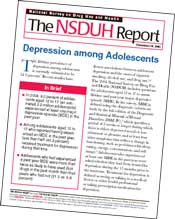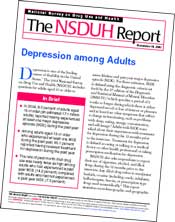Adolescents, Adults Report Major Depression
 SAMHSA's
Office of Applied Studies recently released two reports
revealing that millions of American adolescents and adults
experienced major depression at least once in 2004, with
those suffering from depression more likely to have used
illicit drugs. SAMHSA's
Office of Applied Studies recently released two reports
revealing that millions of American adolescents and adults
experienced major depression at least once in 2004, with
those suffering from depression more likely to have used
illicit drugs.
According to one report, based on data from the 2004
National Survey on Drug Use and Health (NSDUH), 9 percent
of adolescents age
12 to 17 (an estimated 2.2 million) experienced at least
one major depressive episode (MDE) in the 12 months prior
to the survey, with the lifetime prevalence of depression
among adolescents estimated at 14 percent.
 In
the survey, a major depressive episode was defined using
the diagnostic criteria in the fourth edition of the
Diagnostic and Statistical Manual of Mental Disorders
(DSM-IV). These criteria specify a period of 2 weeks
or longer during which there is either depressed mood
or loss of interest or pleasure and other symptoms, such
as problems with sleep, eating, energy, concentration,
and self-image. In
the survey, a major depressive episode was defined using
the diagnostic criteria in the fourth edition of the
Diagnostic and Statistical Manual of Mental Disorders
(DSM-IV). These criteria specify a period of 2 weeks
or longer during which there is either depressed mood
or loss of interest or pleasure and other symptoms, such
as problems with sleep, eating, energy, concentration,
and self-image.
Adolescents who had experienced a major depressive episode
in the past year were more than twice as likely to have
used illicit drugs in the past month (21.2 percent) than
their peers who had not (9.6 percent).
Less than half of the affected adolescents (40.3 percent)
received treatment for depression during that time, but
those with health insurance at the time of the survey
were more likely to have received treatment (41.2 percent)
than those without it (26.9 percent).
In a related NSDUH report, 8 percent of adults age 18
or older (an estimated 17.1 million) reported experiencing
at least one MDE in the 12 months prior to the survey.
The rate of past-month illicit drug use was nearly twice
as high among adults who had experienced an MDE (14.2
percent) compared with those who had not (7.3 percent).
Among affected adults, 65.1 percent had received treatment
for depression. The percent of adults receiving treatment
for depression increased from 46.3 percent for persons
age
18 to 25 to 73.9 percent for persons age 50 to 64.
The reports, Depression
among Adolescents and Depression
among Adults, are available online on the SAMHSA
Web site at www.oas.samhsa.gov. 
« See Also—Previous
Article
See Also—Next Article »
Back to Top
|




